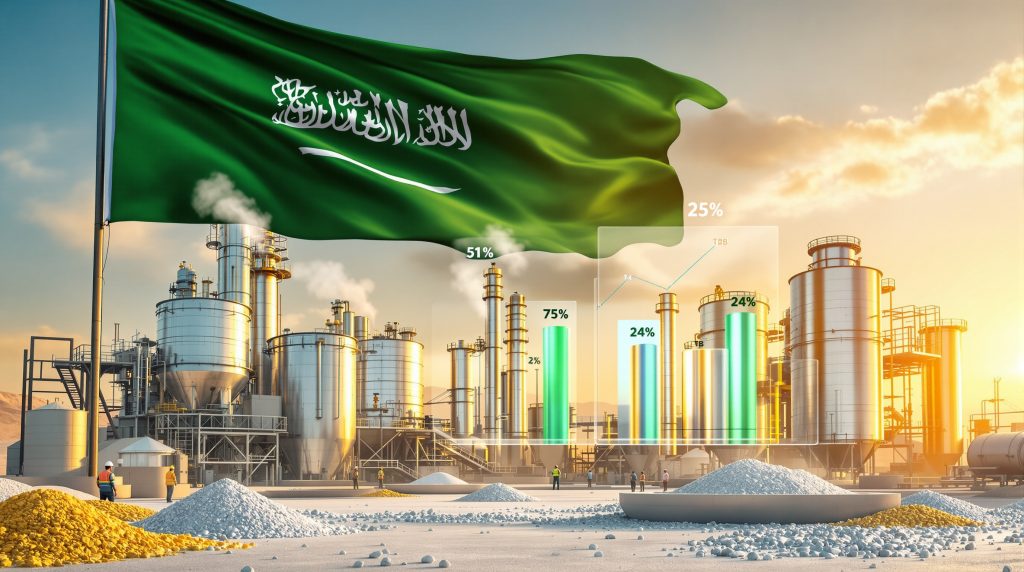The landscape of critical mineral security has fundamentally transformed as nations confront the limitations of purely cost-driven procurement strategies. Modern supply chain vulnerabilities extend beyond traditional market risks, encompassing geopolitical leverage, industrial capacity concentration, and strategic resource control that can reshape entire technological ecosystems. Furthermore, this evolving environment has catalyzed unprecedented partnerships between resource-rich nations and technology-dependent economies, creating new models for mineral security that prioritise resilience over short-term cost optimisation through a comprehensive critical minerals energy transition.
What Strategic Factors Drive the U.S.-Saudi Rare Earth Partnership?
The formation of the U.S.-Saudi Arabia rare earth joint venture represents a strategic response to decades of supply chain concentration that created dangerous vulnerabilities. China's systematic approach to rare earth market dominance involved a 30-year campaign of subsidies, predatory pricing, strategic acquisitions, and export controls that eliminated American refining capacity and triggered widespread factory closures.
According to congressional testimony from MP Materials' leadership, this systematic approach created a deliberate chokehold on Western supply chains, forcing the United States to recognise that national security requires geographic and geopolitical diversification rather than lowest-cost sourcing strategies. Moreover, this shift reflects the broader critical minerals strategy adopted by Western nations.
National Security Imperatives Behind Cross-Border Mineral Alliances
Critical vulnerability factors include:
• China controlling at least 85% of global rare earth refining capacity
• Even greater Chinese dominance in permanent magnet production
• Western buyers paying 15-30% premiums for non-Chinese rare earth supplies
• Limited alternative processing facilities outside Chinese control
The partnership addresses these vulnerabilities by establishing advanced processing capabilities in a strategically positioned, resource-rich allied nation while maintaining Pentagon oversight through direct equity participation. Additionally, this approach builds upon recent developments such as the mineral production executive order that emphasised national security priorities.
Saudi Arabia's Vision 2030 and Mineral Sector Transformation
The Kingdom's economic diversification strategy positions rare earth processing as a cornerstone of post-petroleum prosperity. Saudi Arabia's participation in the joint venture leverages existing energy infrastructure advantages, geographic positioning between Asian and Western markets, and substantial capital resources to capture value-added mineral processing revenues.
This transformation builds upon Saudi Arabia's industrial infrastructure capabilities and abundant low-cost energy resources, creating competitive advantages for energy-intensive rare earth separation processes that require sophisticated chemical operations.
Saudi strategic advantages include:
• Access to subsidised energy for processing operations
• Strategic geographic location serving multiple markets
• Established heavy industry and petrochemical expertise
• Vision 2030 commitment to economic diversification
How Does Joint Venture Ownership Structure Impact Global Market Dynamics?
Majority Saudi Ownership and Its Implications for Supply Chain Control
The ownership structure of the U.S.-Saudi Arabia rare earth joint venture creates a unique governance model where Middle Eastern interests hold controlling stakes in Western-backed critical mineral infrastructure. Saudi Arabia's Ma'aden holds a 51% majority stake, while MP Materials and the U.S. Department of Defense share the remaining 49% ownership.
This structure represents a significant departure from traditional Western-controlled resource partnerships, creating new precedents for allied cooperation in critical mineral security. However, the majority Saudi ownership means operational decisions, pricing mechanisms, and supply allocation strategies will reflect Riyadh's economic interests alongside American security requirements.
| Stakeholder | Ownership % | Strategic Role |
|---|---|---|
| Saudi Arabia (Ma'aden) | 51% | Operational control, domestic integration |
| MP Materials | ~25% | Technical expertise, separation technology |
| U.S. Department of Defense | ~24% | Strategic oversight, security alignment |
Pentagon Investment Strategy in Critical Mineral Infrastructure
Direct Department of Defense equity participation represents a paradigm shift from traditional procurement models to ownership-based supply chain security. This approach provides long-term supply guarantees while sharing financial risks and strategic control with allied nations.
The Pentagon's investment strategy reflects recognition that critical minerals have become equivalent to weapons systems in strategic importance, requiring direct government participation rather than reliance on commercial market mechanisms. Furthermore, this development aligns with broader geopolitical tensions affecting global supply chains, including the ongoing US-China trade war impact on critical materials markets.
Key implications of Pentagon equity investment:
• Guaranteed long-term supply access through ownership rights
• Shared financial risk with allied partners
• Direct oversight of strategic material allocation
• Protection against supply disruption or market manipulation
What Processing Capabilities Will the Saudi Refinery Deliver?
Light and Heavy Rare Earth Separation Technologies
The planned Saudi facility will process both light rare earth elements (LREEs) and heavy rare earth elements (HREEs), addressing critical gaps in non-Chinese processing capacity. This comprehensive approach positions the refinery as a strategic alternative to Chinese-dominated separation infrastructure.
The refinery will transform raw concentrates into high-purity rare earth oxides through sophisticated chemical separation processes, including acid leaching, solvent extraction, and crystallisation stages that require specialised technical expertise and environmental management systems.
Primary processing capabilities:
• Neodymium and praseodymium oxide production for permanent magnet applications
• Dysprosium and terbium separation addressing heavy rare earth scarcity
• Samarium and europium processing for specialised industrial applications
• Industrial-grade purity standards of 99.9%+ suitable for advanced manufacturing
Feedstock Sourcing Strategy and Supply Chain Integration
The refinery's feedstock strategy encompasses both Saudi domestic mining and international concentrate imports, creating a diversified input model that reduces single-source risks while maximising processing efficiency and utilisation rates.
This approach allows the facility to process available Saudi rare earth deposits while maintaining operational flexibility through concentrate imports from approved international sources, supporting consistent throughput and product quality. Consequently, the integrated sourcing model supports broader supply chain security objectives by creating processing capacity that can handle multiple feedstock sources.
How Will This Partnership Affect Global Rare Earth Pricing Mechanisms?
Premium Pricing Models for Non-Chinese Supply
Current market dynamics demonstrate Western buyers' willingness to pay substantial premiums for supply chain security and geopolitical stability. Recent contracts for non-Chinese rare earth materials show 15-30% price premiums over equivalent Chinese domestic pricing, reflecting both supply scarcity and strategic value considerations.
Defense-related procurement has established even higher price floors, with one U.S. military contract setting NdPr oxide prices at approximately $110 per kilogram, roughly double China's domestic price range of $55-60 per kilogram. For instance, this premium structure ensures supplier viability against potential Chinese price competition while guaranteeing strategic supply access.
Current premium pricing structure:
• NdPr oxide: $110/kg (U.S. defense contracts) vs. $55-60/kg (Chinese domestic)
• Dysprosium oxide: 25-30% premium for non-Chinese sources
• Terbium oxide: 20-25% premium for Western supply chains
• General rare earth oxides: 15-30% premium across product categories
Long-Term Contract Structures and Risk Mitigation
The partnership introduces sophisticated contract mechanisms designed to protect both producers and consumers from market manipulation and supply disruption. These arrangements include price floors, take-or-pay provisions, and supply security guarantees that provide unprecedented protection against Chinese market leverage.
Take-or-pay clauses require buyers to pay for predetermined volumes regardless of actual delivery, providing producers with revenue certainty that supports investment in new capacity. In addition, price floors guarantee minimum pricing levels that ensure producer viability even if China attempts predatory pricing strategies.
Advanced contract features include:
• Price floor mechanisms protecting against predatory competition
• Take-or-pay provisions ensuring revenue stability for producers
• Long-term offtake commitments spanning multiple years
• Supply security guarantees prioritising strategic customers
What Are the Broader Geopolitical Implications of U.S.-Saudi Mineral Cooperation?
Middle East Integration into Western Critical Mineral Networks
The U.S.-Saudi Arabia rare earth joint venture represents the first major Middle Eastern entry into rare earth processing, potentially creating a new regional hub for critical mineral value chains that connects Asian suppliers with Western consumers.
This integration extends Western-aligned critical mineral networks beyond traditional partners in Australia, Canada, and Japan, demonstrating the geographic expansion of supply chain security initiatives. However, the Saudi facility's strategic location provides access to both European and Asian markets while maintaining Western operational standards and security protocols.
According to a recent analysis of US-Saudi mineral cooperation, the partnership establishes precedent for resource-rich Middle Eastern nations to participate in advanced manufacturing value chains rather than remaining limited to raw material extraction.
Chinese Response Scenarios and Market Adaptation
China's potential responses to the U.S.-Saudi partnership could include intensified export restrictions, accelerated domestic capacity expansion, or alternative partnership development with other resource-rich nations seeking to challenge Western supply chain initiatives.
Current Chinese export controls already tightly restrict heavy rare earth elements like dysprosium and terbium that are essential for high-performance magnet applications. Furthermore, additional restrictions could further fragment global supply chains while accelerating Western efforts to develop alternative sources.
Potential Chinese countermeasures:
• Expanded export restrictions on critical heavy rare earth elements
• Accelerated African partnership development challenging Western mineral diplomacy
• Enhanced domestic recycling capacity reducing reliance on imported concentrates
• Strategic price competition targeting Western supply chain economics
How Does This Joint Venture Compare to Other Global Critical Mineral Partnerships?
U.S.-Australia vs. U.S.-Saudi Partnership Models
The U.S.-Australia critical minerals framework emphasises mining development and initial processing capabilities, while the Saudi partnership focuses on advanced refining and value-added processing operations. These complementary approaches create integrated supply chain segments rather than competing alternatives.
Australia's partnership model relies primarily on loan guarantees and investment commitments without direct U.S. government equity participation, contrasting with the Pentagon's direct ownership stake in the Saudi venture. This structural difference reflects varying strategic priorities and risk-sharing approaches between different allied partnerships.
| Partnership Aspect | U.S.-Australia | U.S.-Saudi |
|---|---|---|
| Primary Focus | Mining & Initial Processing | Advanced Refining |
| Investment Scale | $2+ billion commitment | $1+ billion estimated |
| Government Role | Loan guarantees | Direct equity investment |
| Timeline | 2022-2030 development | 2025-2028 implementation |
| Strategic Priority | Resource Security | Processing Independence |
European Union Critical Raw Materials Act Response
The European Union's Critical Raw Materials Act targets 10% of annual consumption from domestic extraction and 40% from processing within the bloc by 2030. The U.S.-Saudi partnership could either complement these European objectives through supply agreements or compete for limited global processing capacity and technical expertise.
European initiatives including the European Raw Materials Alliance and specific magnet projects in Estonia demonstrate parallel efforts to reduce Chinese dependency. However, progress remains slower than American initiatives due to limited government financial backing and longer regulatory approval processes.
What Investment Opportunities Does This Partnership Create?
Downstream Manufacturing and Magnet Production Potential
The Saudi refinery creates opportunities for integrated permanent magnet manufacturing facilities within the Kingdom, potentially establishing Saudi Arabia as a regional hub for magnet production serving both Middle Eastern and global markets.
Downstream integration would capture additional value-added processing revenue while providing guaranteed feedstock for magnet manufacturing operations. This vertical integration model follows successful precedents in other industries where resource-rich nations developed complete value chains rather than remaining limited to raw material export.
Potential downstream opportunities:
• Permanent magnet manufacturing for regional automotive and renewable energy markets
• Specialised alloy production for aerospace and defence applications
• Magnet recycling facilities creating circular supply mechanisms
• Technology licensing for additional regional processing capacity
Technology Transfer and Intellectual Property Considerations
The partnership involves significant technology transfer from MP Materials to Saudi operations, creating precedents for future international rare earth cooperation while protecting proprietary separation technologies through licensing agreements and operational controls.
Technology transfer arrangements must balance knowledge sharing necessary for operational success with intellectual property protection that preserves competitive advantages for American technology providers. This balance requires sophisticated legal frameworks and ongoing technical cooperation that reflect the broader mining industry evolution towards international collaboration.
What Challenges Could Impede Partnership Success?
Technical Complexity and Operational Risk Factors
Rare earth separation requires sophisticated chemical processes, environmental management systems, and specialised workforce capabilities that may present implementation challenges in new geographic contexts. The complexity of solvent extraction, crystallisation, and purification processes demands consistent technical execution and quality control.
Environmental compliance presents particular challenges given the radioactive byproducts and chemical waste streams inherent in rare earth processing. Saudi Arabia must demonstrate environmental management standards equivalent to Western regulatory requirements to maintain operational legitimacy and market access.
Primary risk factors:
• Environmental compliance and radioactive waste management requirements
• Skilled workforce development for specialised chemical processing operations
• Technology transfer execution ensuring successful knowledge transfer
• Market demand volatility affecting long-term project viability
• Quality control consistency maintaining product specifications for demanding applications
Regulatory and Trade Policy Uncertainties
Changing U.S. trade policies, evolving Saudi regulatory frameworks, and potential international sanctions regimes could impact partnership operations, requiring robust legal structures and comprehensive contingency planning.
Trade policy changes affecting critical mineral partnerships, export controls on dual-use technologies, or shifts in U.S.-Saudi diplomatic relationships could create operational challenges requiring contractual protection mechanisms and government-level dispute resolution procedures.
How Will This Partnership Influence Future Critical Mineral Diplomacy?
Template for Resource-Rich Nation Partnerships
The U.S.-Saudi Arabia rare earth joint venture model could serve as a template for similar partnerships with other resource-rich nations seeking to develop value-added mineral processing capabilities while supporting Western supply chain security objectives.
This partnership structure demonstrates how majority ownership by allied nations can be combined with American technical expertise and Pentagon oversight to create mutually beneficial critical mineral infrastructure. The model balances commercial viability with strategic security requirements through innovative ownership and governance arrangements.
Replicable partnership elements:
• Majority allied nation ownership ensuring local economic benefits
• American technical partnership providing separation technology and expertise
• Pentagon equity participation guaranteeing strategic alignment
• Sophisticated contract structures protecting all stakeholder interests
Integration with Existing Allied Frameworks
The partnership must coordinate with existing U.S. critical mineral alliances including the Minerals Security Partnership and bilateral agreements with Australia, Canada, and Japan to avoid duplication and maximise synergies across multiple supply chain initiatives.
Integration challenges include ensuring complementary rather than competitive capacity development, coordinating offtake agreements to avoid market oversupply, and maintaining consistent technical and environmental standards across different partnership models. Recent reports from MP Materials indicate strong performance following the announcement of the Saudi venture.
Successful integration could create a comprehensive network of allied critical mineral processing capacity that provides redundancy, geographic distribution, and supply chain resilience against potential Chinese market manipulation or geopolitical disruption.
Disclaimer: This analysis contains forward-looking projections and strategic assessments that involve inherent uncertainties. Rare earth market dynamics, geopolitical relationships, and technological developments may differ significantly from current expectations. Investment decisions should consider comprehensive risk assessments and professional guidance. Pricing information reflects available public sources but may not represent current market conditions.
Looking to Capitalise on Critical Minerals Investment Opportunities?
Discovery Alert's proprietary Discovery IQ model delivers instant alerts on significant ASX mineral discoveries, including critical minerals companies positioned to benefit from evolving global supply chain dynamics. With rare earth partnerships reshaping international markets and creating new investment opportunities, subscribers gain immediate access to emerging prospects across over 30 commodities, ensuring they're positioned ahead of major market movements through Discovery Alert's comprehensive discoveries page.




